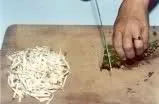 Durian is widely known and revered in southeast Asia as the “king of fruits”, the durian is distinctive for its large size, unique odor, and formidable thorn-covered husk.
Durian is widely known and revered in southeast Asia as the “king of fruits”, the durian is distinctive for its large size, unique odor, and formidable thorn-covered husk.
According to Department of Agriculture’s High Value Commercial Crops Regional Coordinator Melani A. Provido, the Philippines is producing around 54,700 metric tons of durian annually, with majority of production areas located in Mindanao.
The flesh and seeds make up around 60 percent of the fruit, while the husk or skin which is generally considered waste material represents 40 percent or 21,880 metric tons. Hence, every year, we are producing around 22,000 metric tons of durian husk, which usually end up in the garbage dumps or worse, are just left along the sides of the streets to rot.
Instead of just dumping durian rinds to waste, women’s organization called KATAKUS in Panabo City, Davao, utilizes the rind as one of the raw materials in making handmade paper.
One of the objectives is to increase income of farm households through collective and individual on-farm and off farm enterprises and one of which is the handmade paper production project.
Through a training conducted by DEV link and the Department of Science and Technology in 1994, they learned the technology on the production of hand made paper, which involves the use of cogon, banana fiber, abaca fiber waste, and durian fiber. Here is the procedure to process durian rind paper adopted from Chanthaburi Horticulture Research Center, Thailand:
Processing Durian Rinds into Paper
* 1. Wash durian rinds in clean water and then soak them in 1 g, or one teaspoon, of potassium permanganate in 20 liters of water for about 30 minutes.
* 2. Slice the soaked durian rinds into small pieces (Fig. 1).
* 3. Tear paper, or newsprint, into small pieces and soak them for 24 hours.
* 4. Weigh durian rinds and paper at a ratio of 7:1 or 1.75 kg durian rinds to 0.25 kg paper.
* 5. Boil durian rinds (Fig. 2 and Fig. 3) in 4 liters of water for about one hour and leave to cool.
* 6. Stir durian rinds, boiled water and paper together, put everything in a tank with 40 liters of water. Blend them together.
* 7. Make a sieve using No. 16 nylon on a wood frame.
* 8. Sieve the blended durian rinds and paper, grade filament consistently and all over the sieve. Thickness and neatness depends on graders’ skills.
* 9. Dry the sieve in the sunshine for about 5 hours. Filament will be dried and paper can be removed from the sieve (Fig. 4).
* 10. Keep the dried paper in a dry place for later use.
Paper made will be naturally brown. Dye can be added into the tank before sieving for a more colorful paper (20 g of dye/4 kg of raw materials).
Designs can be made by adding rose petals or leaves soon after sieving, but before drying it in the sunshine. Beautiful designs depend on the maker’s skills. Paper made from durian rinds is natural and has no caustic soda, thus safe to users.
Paper made from durian rinds offers tender filament and better quality than mulberry-pulp paper. Durian rinds may be blended with fruit or vegetable fibers to produce different kinds of paper. For instance, if blended with rambutan rinds, it will have a natural reddish color; with mangosteen rinds, a natural violet paper; with dragon fruit skin, a violet and tender paper.
The proportion of fruit, or vegetable fibers with durian rinds, depends on the type of fruit, or vegetable, but it should not exceed 50 percent of the total materials as it will affect the paper quality.
Images:

Figure 2. Boil Durian Rinds.

Figure 3. Durian Rinds after Boiling.

Figure 4. Removing DRY Paper from the Sieve.

Based on what they experienced, KATAKUS said that products made from durian paper such as lamps, paper bags, scrapbooks, and photo albums are more popular among customers due to its attractive natural colors and texture.
Cooperating agency for this topic:
Chanthaburi Horticulture Research Center, Tapon Sub-district
Khlung District, Chanthaburi Province 22110, Thailand
Tel: 66-3939-7030
Fax. 66-3939-7236
E-mail: chrc@ksc.th.com, 2005-12-01
For more information, interested individuals may contact KATAKUS through its office in Davao City located at Room 32/F Via’s Court, 53 Legaspi Street, with telephone number (6382) 221-8157 and email address katakus@skynet.net.
Source: FFTC for the Asian and Pacific Region, en.wikipedia.org, agribusinessweek.com. Photo: FFTC
Do you like this money making business idea? then please consider subscribing to our RSS feed and have new articles sent directly to your inbox. (Once you entered your e-mail address, you need to login to your e-mail account and click the link to confirm your subscription).

can you help us more? because this topic is our investigation for SIP, we are just grade 7 students and we need your help…
how long should we boil the durian rinds, where can u buy sieve and what should we do with the sieve? please reply we really need this. Thank you
WOW! Thank You! ^_^
OTHER IDEA OF THIS?
where can i get the whole study about this? i just need it for my RRL